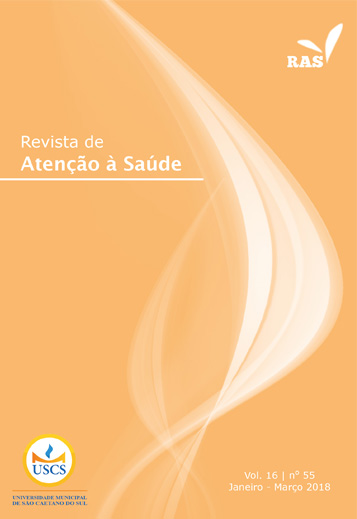INCIDENCE OF BLOODSTREAM INFECTIONS IN PATIENTS WITH KIDNEY DISEASE
DOI:
https://doi.org/10.13037/ras.vol16n55.4934Keywords:
Cross infection, chronic renal insufficiency, renal dialysisAbstract
Objective: To identify the incidence of bloodstream infections in patients with chronic renal insufficiency on hemodialysis and to identify the profile of the most frequently found etiological agents in blood cultures performed for diagnosis of antimicrobial susceptibility. Methodology: This is a quantitative, documental, descriptive, exploratory and cross-sectional study, developed at a referral service in nephrology in the municipality of Montes Claros, Minas Gerais, Brazil. The information was collected between August and December 2013, through institutional documents, such as case histories, patients’ records and results of microbiological examinations of blood cultures. To evaluate the sensitivity profile of the bacteria isolated in the blood cultures, a protocol from the Infection Control Service of the hospital under study was used. Results: During the period 100 patients who underwent blood culture were included, 60% of whom was male and 40% was female. A total of 54.5% of the patients were older than 60 years. A total of 152 blood cultures was analyzed, of which 74 were positive (58.9%). The most prevalent bacteria in the bloodstream infections was Staphylococcus aureus (57.6%). Conclusion: It can be concluded that the incidence of infection by multiresistant bacteria is high and the Staphylococcus aureus stands out. The isolation of these multiresistant bacteria is worrying, due to the limitations of therapeutic options and the increasing lethality.
Downloads
References
Jha V, Garcia-Garcia G, Iseki K, Li Z, Naicker S, Plattner B, et al. Chronic kidney disease: global dimension and perspectives. Lancet. 2013;382(9888):260-72.
Santos BP, Oliveira VA, Soares MC, Schwartz E. Doença renal e relação com a hemodiálise. ABCS Health Sci. 2017;42(1):8-14.
Sociedade Brasileira de Nefrologia. Hemodiálise [Internet]. 2017 [citado em 2017 set 17]. Disponível em: https://goo.gl/EpUYxa
Menezes FG, Barreto DV, Abreu RM, Roveda F, Pecoits Filho RFS. Panorama do tratamento hemodialítico financiado pelo Sistema Único de Saúde: uma perspectiva econômica. J Bras Nefrol. 2015; 37(3):367-78.
Ribeiro LC, Arreguy-Sena C, Souza LC, Oliveira DV. Significados atribuídos à fístula arteriovenosa pela pessoa em hemodiálise. HU Rev. 2013;39(1-2):45-52.
Danski MTR, Pontes L, Schwanke AA, Lind J. Infecção da corrente sanguínea relacionada a cateter venoso central para hemodiálise: revisão integrativa. Rev Baiana Enferm. 2017; 31(1):1-10.
Brasil. Agência Nacional de Vigilância Sanitária. Critérios diagnósticos de infecção relacionada à assistência à saúde [Internet]. 2ª ed. Brasília, DF; 2017 [citado em 2017 set 17]. Disponível em: https://goo.gl/cD4aQs
Fram DS, Taminato M, Ferreira D, Neves L, Belasco AG, Barbosa DA. Prevention of catheter-related bloodstream infections in patients on hemodialysis. Acta Paul Enferm. 2009; 22(Spec 1):564-8.
Rosado V, Romanelli RMC, Camargos PAM. Risk factors and preventive measures for catheter-related bloodstream infections. J Pediatr (Rio J). 2011;87(6):469-77.
Rossi F, Andreazzi DB. Resistência bacteriana: interpretando o antibiograma. São Paulo: Atheneu; 2005.
Brasil. Agência Nacional de Vigilância Sanitária. Corrente sanguínea: critérios nacionais de infecções relacionados à assistência à saúde [Internet]. [S.l.]; 2009 [citado em 2017 set 17]. Disponível em: https://goo.gl/t8GHvY
Grothe C, Belasco AGS, Bittencourt ARC, Vianna LA, Sesso RCC, Barbosa DA. Incidence of bloodstream infection among patients on hemodialysis by central venous catheter. Rev Lat Am Enfermagem. 2010;18(1):73-80.
Solano LC, Bezerra MAC, Medeiros RS, Carlos EF, Carvalho FP, Miranda FAN. O acesso do homem ao serviço de saúde na atenção primária. Rev Pesqui Cuid Fundam (Online). 2017;9(2):302-8.
Izaias EM, Dellaroza MSG, Rossaneis MA, Belei RA. Custo e caracterização de infecção hospitalar em idosos. Ciênc Saúde Coletiva. 2014;19(8):3395-402.
Sesso RCC, Lopes AA, Thomé FS, Lugon JR, Watanabe Y, Santos DR. Diálise crônica no Brasil: relatório do Censo Brasileiro de Diálise, 2011. J Bras Nefrol. 2012;34(3):272-7.
Henrique DM, Tadeu CN, Alves FH, Trindade LPC, Fernandes MSR, Macedo ML, et al. Fatores de risco e recomendações atuais para prevenção de infecção associada a cateteres venosos centrais: uma revisão de literatura. Rev Epidemiol Control Infect. 2013;3(4):134-8
Bevilacqua JL, Gomes JG, Santos VFB, Canziani MEF. Comparação entre citrato trissódico e heparina como solução para selo de cateter em pacientes em hemodiálise. J Bras Nefrol. 2011;33(1):86-92.
Leão LSNO, Passos XS, Reis C, Valadão LMA, Silva MRR, Pimenta FC. Fenotipagem de bactérias isoladas em hemoculturas de pacientes críticos. Rev Soc Bras Med Trop. 2007;40(5):537-40.
Machado GM, Lago A, Fuentefria SRR, Fuentefria DB. Ocurrence and the susceptibility to antimicrobial agents in Pseudomonas aeruginosa and Acinetobacter sp. at a tertiary hospital in southern Brazil. Rev Soc Bras Med Trop 2011;44:168-72.
Rodrigues LS, Gioia TSRD, Rossi F. Stenotrophomonas maltophilia: resistência emergente ao SMX-TMP em isolados brasileiros. uma realidade? J Bras Patol Med Lab. 2011;47(5):511-7.
Esmanhoto CG, Taminato M, Fram DS, Belasco AGS, Barbosa DA. Microrganismos isolados de pacientes em hemodiálise por cateter venoso central e evolução clínica relacionada. Acta Paul Enferm. 2013;26(5):413-20.
Naves KSC, Trindade NV, Gontijo Filho PP. Methicillin-resistant Staphylococcus aureus bloodstream infection: risk factors and clinical outcome in non-intensive-care units. Rev Soc Bras Med Trop. 2012;45(2):189-93.
Downloads
Published
Issue
Section
License
Policy Proposal for Journals offering Free Delayed Access
Authors who publish in this magazine agree to the following terms:
- Authors maintain the copyright and grant the journal the right to the first publication, with the work simultaneously licensed under a Creative Commons Attribution License after publication, allowing the sharing of the work with recognition of the authorship of the work and initial publication in this journal.
- Authors are authorized to assume additional contracts separately, for non-exclusive distribution of the version of the work published in this magazine (eg, publishing in institutional repository or as a book chapter), with the acknowledgment of the authorship and initial publication in this journal.
- Authors are allowed and encouraged to publish and distribute their work online (eg in institutional repositories or on their personal page) at any point before or during the editorial process, as this can generate productive changes, as well as increase impact and citation of the published work (See The Effect of Open Access).









